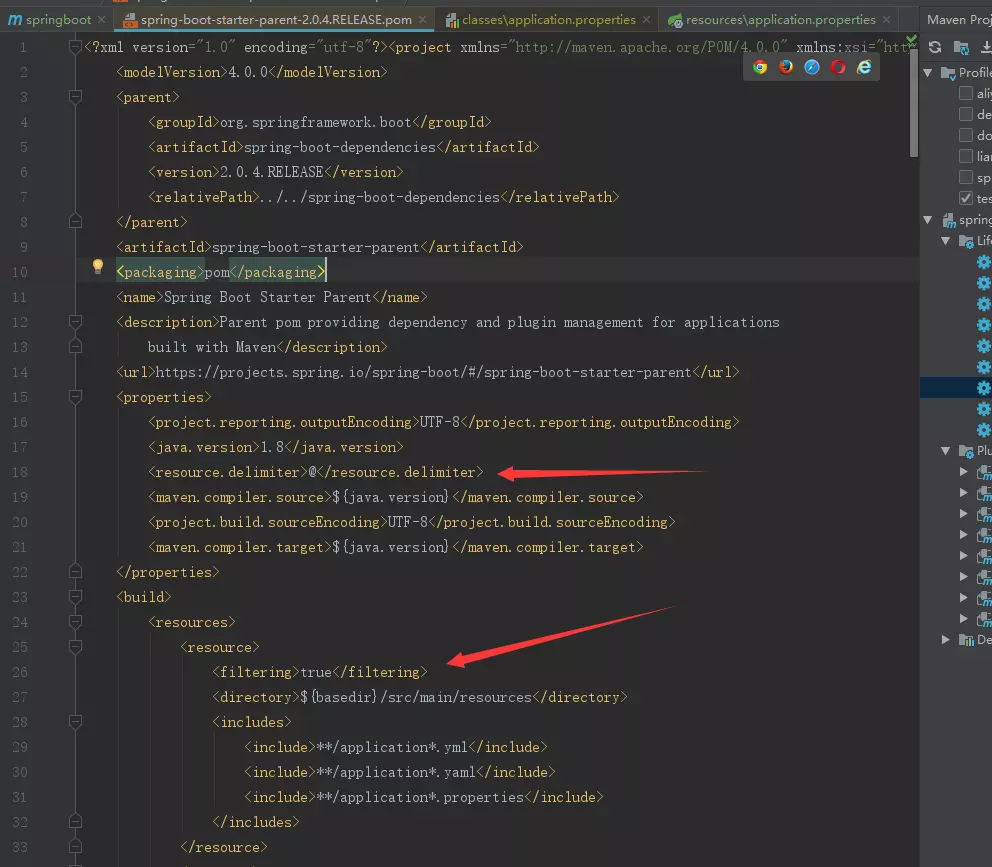前言:
最近在项目中使用springboot时发现,采用在pom中定义不同的profile,并且maven打包时
采用-P参数并不能替换我application.properties文件中指定占位符的问题。
配置文件布局:

在application.properties中定义整个项目中不同环境下共通的配置属性,并采用springboot针对配置文件的特性 - spring.profiles.active=dev或者test
来自动加载合并application-dev/test.properties中特有的配置的功能,开发,测试,生产环境配置文件命名方面需要遵守springboot的约束即可。
Maven pom 配置:


备注:实际上使用springboot,上述的<resources>标签,以及<outputDirectory>都是不需要的,其都已经定义过了。在这里写出来只是为了讲述maven打包的原理。
执行打包命令:
进入项目pom文件所在目录,执行
mvn clean package -P test
命令解释:
1:执行后会根据pom中定义的profiles标签寻找对应的profile id为test的,将其properties下的子标签获取到,拿到key = boot.profile,value = test。放入map中
2:根据 build中定义的resources标签,开始打包对应的资源文件,由于指定了filtering为true,故会将上一步中得到的map中的key拿去替换resource中指定的资源文件中的占位符${key},为value值。
遇到的问题:

执行后查看classes文件下的资源文件,发现并没有替换掉
原因:
发现最终是因为springboot导致的,查看其pom继承,

进入后发现,springboot默认指定资源文件中的占位符为@@,并不是maven默认的 ${}


解决方案:
1:将application.properties中的占位符由${key} -> @key@
2:覆盖springboot的默认规则
1 <build> 2 <finalName>${project.artifactId}</finalName> 3 <resources> 4 <resource> 5 <filtering>true</filtering> 6 <directory>${basedir}/src/main/resources</directory> 7 <includes> 8 <include>**/application*.yml</include> 9 <include>**/application*.yaml</include> 10 <include>**/*.properties</include> 11 </includes> 12 </resource> 13 <resource> 14 <directory>${basedir}/src/main/resources</directory> 15 <excludes> 16 <exclude>**/application*.yml</exclude> 17 <exclude>**/application*.yaml</exclude> 18 <exclude>**/*.properties</exclude> 19 </excludes> 20 </resource> 21 </resources> 22 <plugins> 23 <plugin> 24 <groupId>org.springframework.boot</groupId> 25 <artifactId>spring-boot-maven-plugin</artifactId> 26 </plugin> 27 <plugin> 28 <artifactId>maven-resources-plugin</artifactId> 29 <configuration> 30 <encoding>utf-8</encoding> 31 <useDefaultDelimiters>true</useDefaultDelimiters> 32 </configuration> 33 </plugin> 34 </plugins> 35 </build>
3:测试了再自己的pom中不增加resource配置,只是增加

也是可以的哦
建议:
既然已经使用了springboot,就不要再用回之前的写法了,平白增加配置。
附:pom的profile导入.properties
方法1:
1 <profiles> 2 <!--开发环境--> 3 <profile> 4 <id>dev</id> 5 <activation> 6 <activeByDefault>true</activeByDefault> 7 </activation> 8 <properties> 9 <spring.profiles.active>dev</spring.profiles.active> 10 </properties> 11 <build> 12 <filters> 13 <filter>${basedir}/src/main/resources/application-dev.properties</filter> 14 </filters> 15 </build> 16 </profile> 17 <!--预发环境--> 18 <profile> 19 <id>pre</id> 20 <activation> 21 <activeByDefault>true</activeByDefault> 22 </activation> 23 <properties> 24 <spring.profiles.active>pre</spring.profiles.active> 25 </properties> 26 <build> 27 <filters> 28 <filter>${basedir}/src/main/resources/application-pre.properties</filter> 29 </filters> 30 </build> 31 </profile> 32 </profiles>
方法2:
1 <profiles> 2 <!--开发环境--> 3 <profile> 4 <id>dev</id> 5 <activation> 6 <activeByDefault>true</activeByDefault> 7 </activation> 8 <properties> 9 <spring.profiles.active>dev</spring.profiles.active> 10 </properties> 11 </profile> 12 <!--预发环境--> 13 <profile> 14 <id>pre</id> 15 <activation> 16 <activeByDefault>true</activeByDefault> 17 </activation> 18 <properties> 19 <spring.profiles.active>pre</spring.profiles.active> 20 </properties> 21 </profile> 22 </profiles> 23 24 <build> 25 <filters> 26 <filter> 27 ${basedir}/src/main/resources/application-${spring.profiles.active}.properties 28 </filter> 29 </filters> 30 </build>